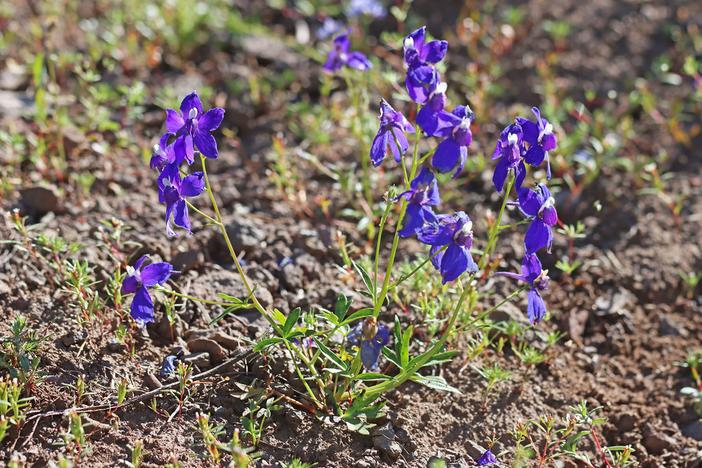Nuttall’s Larkspur
(Delphinium nuttallii)
Nuttall’s Larkspur (Delphinium nuttallii)
/
/

Andrey Zharkikh
CC BY 2.0
Image By:
Andrey Zharkikh
Recorded By:
Copyright:
CC BY 2.0
Copyright Notice:
Photo by: Andrey Zharkikh | License Type: CC BY 2.0 | License URL: https://creativecommons.org/licenses/by/2.0/ | Uploader: AndreyZharkikh | Publisher: Flickr











Estimated Native Range
Summary
Delphinium nuttallii, commonly known as Nuttall’s larkspur, is a perennial herb native to the Pacific Northwest, specifically the Columbia River Gorge, where it thrives in open woodlands, grassy slopes, and meadow habitats. It is characterized by its erect, divided stems that are covered in fine hairs and typically grows to a height of 12-36 inches (30-91 cm). The plant features striking light to deep blue flowers with long slender spurs and pale blue notched petals, which are highly showy and bloom in spring to early summer. The foliage is finely dissected, adding a delicate texture to garden settings.
Nuttall’s larkspur is valued for its vibrant blue flowers that provide a burst of color in wildflower gardens, meadow plantings, and informal borders. It is relatively easy to maintain, requiring minimal care once established. This species prefers well-drained soils and full sun to part shade conditions. While it is drought-tolerant once established, regular watering during prolonged dry periods will keep it looking its best. It is important to note that all parts of the plant are toxic if ingested, so it should be planted with caution in areas accessible to children and pets. Nuttall’s larkspur can be susceptible to crown rot if grown in poorly drained soils or overly wet conditions.CC BY-SA 4.0
Nuttall’s larkspur is valued for its vibrant blue flowers that provide a burst of color in wildflower gardens, meadow plantings, and informal borders. It is relatively easy to maintain, requiring minimal care once established. This species prefers well-drained soils and full sun to part shade conditions. While it is drought-tolerant once established, regular watering during prolonged dry periods will keep it looking its best. It is important to note that all parts of the plant are toxic if ingested, so it should be planted with caution in areas accessible to children and pets. Nuttall’s larkspur can be susceptible to crown rot if grown in poorly drained soils or overly wet conditions.CC BY-SA 4.0
Plant Description
- Plant Type: Herb
- Height: 0.6-1.75 feet
- Width: 0.6-1 feet
- Growth Rate: Moderate
- Flower Color: Blue, Purple, White
- Flowering Season: Spring, Summer
- Leaf Retention: Deciduous
Growth Requirements
- Sun: Full Sun, Part Shade
- Water: Medium
- Drainage: Medium
Common Uses
Bee Garden, Bird Garden, Border Plant, Butterfly Garden, Deer Resistant, Hummingbird Garden, Low Maintenance
Natural Habitat
Open woodlands, grassy slopes, and meadow habitats in the Pacific Northwest
Other Names
Common Names: Nuttall’s Larkspur, Two-lobe Larkspur
Scientific Names: , Delphinium nuttallii, Delphinium bicolor var. nuttallii,
GBIF Accepted Name: